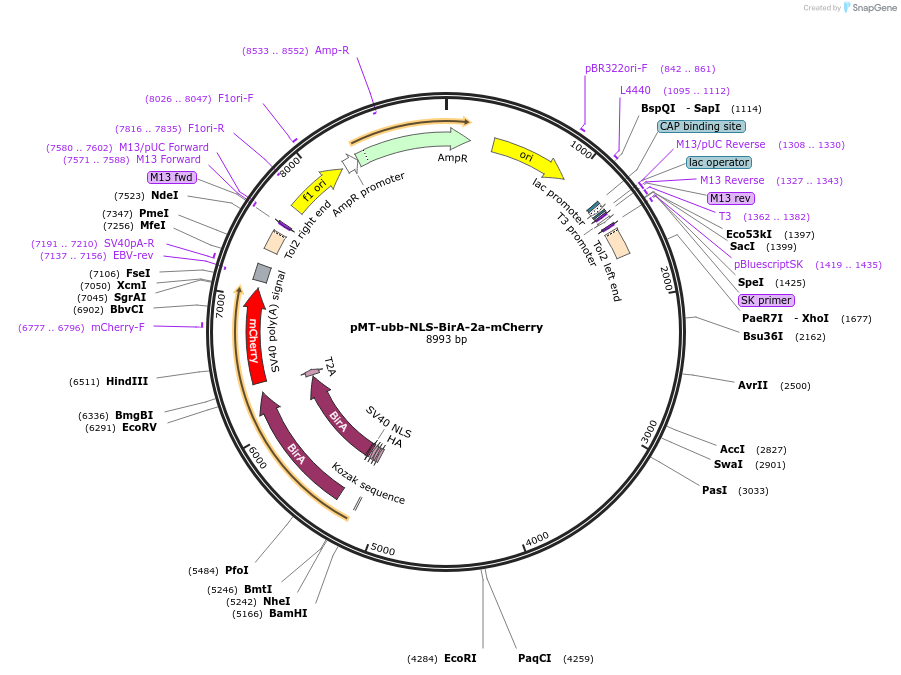pMT-ubb-NLS-BirA-2a-mCherry
(Plasmid
#79886)
-
PurposeUbiquitin promoter driving HA-tagged biotin ligase (BirA) with nuclear localization signal (NLS), a Thosea asigna virus peptide (2A), and mCherry protein; flanked by Tol2 sequences
-
Depositing Lab
-
Sequence Information
Ordering
| Item | Catalog # | Description | Quantity | Price (USD) | |
|---|---|---|---|---|---|
| Plasmid | 79886 | Standard format: Plasmid sent in bacteria as agar stab | 1 | $89 | |
Backbone
-
Vector backbonepMT
- Backbone size w/o insert (bp) 6903
- Total vector size (bp) 8993
-
Vector typeBacterial Expression
Growth in Bacteria
-
Bacterial Resistance(s)Ampicillin, 100 μg/mL
-
Growth Temperature37°C
-
Growth Strain(s)DH5alpha
-
Copy numberHigh Copy
Gene/Insert
-
Gene/Insert nameBiotin ligase (BirA) with nuclear localization signal (NLS), a Thosea asigna virus peptide (2A), and mCherry protein
-
SpeciesD. rerio (zebrafish)
-
Insert Size (bp)2090
- Promoter Ubiquitin
-
Tag
/ Fusion Protein
- 3x HA (N terminal on insert)
Cloning Information
- Cloning method Gibson Cloning
- 5′ sequencing primer ACATGGGAGAAGTGCAAAACA
- 3′ sequencing primer gcatgcgtttaaacccggg
- (Common Sequencing Primers)
Resource Information
-
A portion of this plasmid was derived from a plasmid made byUbiquitin promoter from Addgene plasmid 27320 (Mosimann et al., 2011)
Terms and Licenses
-
Academic/Nonprofit Terms
-
Industry Terms
- Not Available to Industry
Trademarks:
- Zeocin® is an InvivoGen trademark.
These plasmids were created by your colleagues. Please acknowledge the Principal Investigator, cite the article in which the plasmids were described, and include Addgene in the Materials and Methods of your future publications.
-
For your Materials & Methods section:
pMT-ubb-NLS-BirA-2a-mCherry was a gift from Tatjana Sauka-Spengler (Addgene plasmid # 79886 ; http://n2t.net/addgene:79886 ; RRID:Addgene_79886) -
For your References section:
Biotagging of Specific Cell Populations in Zebrafish Reveals Gene Regulatory Logic Encoded in the Nuclear Transcriptome. Trinh LA, Chong-Morrison V, Gavriouchkina D, Hochgreb-Hagele T, Senanayake U, Fraser SE, Sauka-Spengler T. Cell Rep. 2017 Apr 11;19(2):425-440. doi: 10.1016/j.celrep.2017.03.045. 10.1016/j.celrep.2017.03.045 PubMed 28402863







